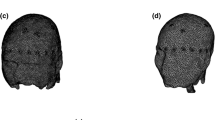Abstract
The conductivity of the human skull plays an important role in source localization of brain activity, because it is low as compared to other tissues in the head. The value usually taken for the conductivity of skull is questionable. In a carefully chosen procedure, in which sterility, a stable temperature, and relative humidity were guaranteed, we measured the (lumped, homogeneous) conductivity of the skull in five patients undergoing epilepsy surgery, using an extended four-point method. Twenty-eight current configurations were used, in each of which the potential due to an applied current was measured. A finite difference model, incorporating the geometry of the skull and the electrode locations, derived from CT data, was used to mimic the measurements. The conductivity values found were ranging from 32 mS/m to 80 mS/m, which is much higher than the values reported in other studies. Causes for these higher conductivity values are discussed.
Similar content being viewed by others
References
Akhtari M., Bryant, H., Mamelak, A., Heller, L., Shih, J., Mandelkern, M., Matlachov, A., Ranken, D., Best, E. and Sutherling, W. Conductivities of three-layer human skull. Brain Topogr., 2000, 13: 29–42.
Akhtari M., Bryant, H., Mamelak, A., Flynn, E., Heller, L., Shih, J., Mandelkern, M., Matlachov, A., Ranken, D., Best, E., DiMauro, M., Lee, R. and Sutherling, W. Conductivities of three-layer live human skull. Brain Topogr., 2002, 14: 151–167.
Alcouffe R., Dendy, J. and Brandt, A. The multigrid solution for problems with strongly discontinuous and anisotropic coefficients. SIAM J. Sci. Comput., 1981. 2: 430–454.
Brandt, A. Multigrid techniques: 1984 guide with applications to fluid dynamics. In: GMD Studien No. 85, Gesellschaft für Mathematik und Datenverarbeitung MBH, Bonn, Germany, 1984.
Goncalves, S., de Munck, J., Heethaar, R., Lopes da Silva, F. and van Dijk, B. The application of electrical impedance tomography to reduce systematic errors in the eeg inverse problem-a simulation study. Physiol. Meas., 2000: 379–393.
Hoekema, R., Venner, K., Struijk, J. and Holsheimer, J. Multigrid solution of the potential field in modeling electrical nerve stimulation. Comput. Biomed. Res., 1998. 31: 348–362.
Huiskamp, G., Vroeijenstijn, M., van Dijk, R., Wieneke, G. and van Huffelen, A.C. The need for correct realistic geometry in the inverse EEG problem. IEEE Trans. Biomed. Engr., 1999, 46: 1281–1287.
Kosterich, J.D., Foster, K.R. and Pollack, S.R. Dielectric properties of fluid saturated bone: The effect of variation in conductivity of immersion fluid. IEEE Trans. Biomed. Engr., 1984, 31: 369–375.
Law, S. Thickness and resistivity variations over the upper surface of the human skull. Brain Topography, 1993, 3: 99–109.
Oostendorp, T., Delbeke, J. and Stegeman, D. The conductivity of the human skull: results of in vivo and in vitro measurements. IEEE Trans. Biomed. Engr., 2000, 47: 1487–1492.
Rush, S. and Driscoll, D.A. Current distribution in the brain from surface electrodes. Anesthesia Analgesia, 1968, 47: 717–723.
Rush, S. and Driscoll, D.A. EEG electrode sensitivity: an application of reciprocity. IEEE Trans. Biomed. Eng., 1969, BME-16: 15–22.
Saha, S. and Williams, P.A. Electric and dielectric properties of wet human cortical bone as a function of frequency. IEEE Trans. Biomed. Eng., 1992. BME:39/12: 1298–1304.
Saha, S., Reddy, G. and Albright, J. Factors affecting the measurement of bone impedance. Med. and Biol. Eng. and Comput., 1984, 22: 123–129.
Viergever, M., Maintz, J., Niessen, W., Noordmans, H., Pluim, J., Stokking, R. and Vincken, K. Registration, segmentation, and visualization of multimodal brain images. Comput. Med. Imaging Graph, 2001, 25: 147–151.
Author information
Authors and Affiliations
Rights and permissions
About this article
Cite this article
Hoekema, R., Wieneke, G., Leijten, F. et al. Measurement of the Conductivity of Skull, Temporarily Removed During Epilepsy Surgery. Brain Topogr 16, 29–38 (2003). https://doi.org/10.1023/A:1025606415858
Issue Date:
DOI: https://doi.org/10.1023/A:1025606415858




